XFX Speedster Merc 310 7900 XTX review: Silent, frigid, and powerful
 At a glance
At a glance
Expert’s Rating
Pros
- Much faster than the RTX 4080
- Sometimes faster than the RTX 4090, especially at 1440p
- $200 less than 4080 and $600 less than 4090
- 24GB VRAM
- Frigid, silent custom cooler
- Secondary max-power BIOS and extra power connector for OC enthusiasts
Cons
- Massive
- High power draw
- Ray tracing matches 3090 but lags behind RTX 40-series
Our Verdict
The XFX Speedster Merc 310 essentially perfects AMD’s Radeon RX 7900 XTX formula, using heavy metal to tame AMD’s powerful GPU to spectacular effect. It’s huge and power hungry, but still cheaper and faster than the cheapest RTX 4080 models even with a worth-it $100 price premium over the reference XTX. Ray tracing enthusiasts will want to splurge for an Nvidia RTX 40-series card, however.
Can AMD’s superb RDNA 3 graphics cards be improved upon? The $999 Radeon RX 7900 XTX hits the streets today, offering sublime performance that sprints past Nvidia’s $1,200 GeForce RTX 4080 and challenges the $1,600 RTX 4090 for hundreds of dollars less. It’s a rip-roaring winner of a GPU, as our review of AMD’s Radeon RX 7900 XTX reference card showed—but AMD’s board design itself isn’t flawless.
With Nvidia’s rival RTX 40-series cards universally opting for gargantuan 3- to 4-slot coolers to tame their large “Ada Lovelace” GPUs, AMD took the opposite route, trotting out a clean, attractive 2.5-slot reference card that fits into virtually any PC. That’s great for compatibility, but there’s a trade off: Using a smaller cooler for the power-hungry XTX means the reference card has fine, but higher-than-usual temperatures and, more tangibly, you can definitely hear its fans, even though we wouldn’t call it loud. Our model also suffered from coil whine, a complaint we saw from other reviewers as well.
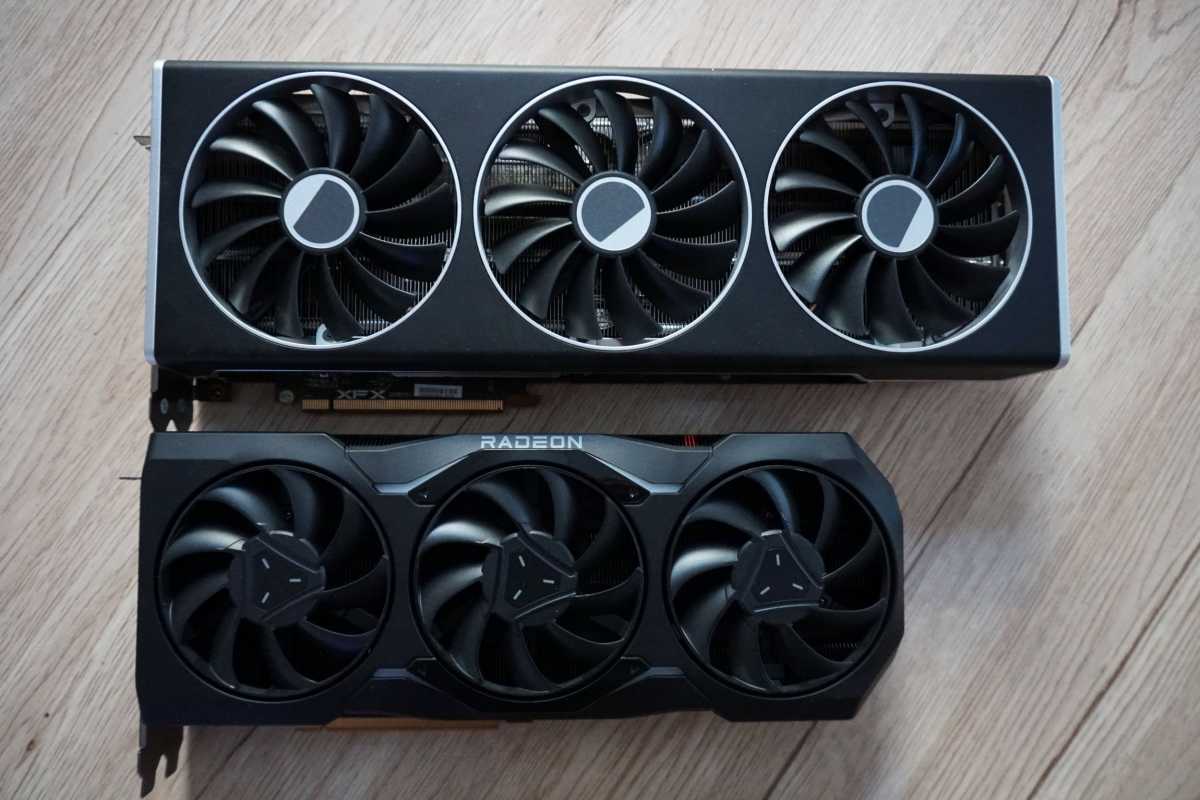
The XFX Speedster Merc 310 next to AMD’s reference Radeon RX 7900 XTX.
Brad Chacos/IDG
Enter custom boards like the $1,099 XFX Speedster Merc 310 7900 XTX we’re reviewing today. The Merc 310 deploys XFX’s usual big, badass, sleeky industrial design philosophy and it works to great effect, offering frigid temperatures and silent running. XFX also added a third 8-pin power connector and an optional secondary BIOS switch that pumps power from 327W to 339W, maxing out AMD’s Powerplay recommendations to give overclocking enthusiasts plenty of room to work with.
If you can fit this chonky looker in your case, the XFX Speedster Merc 310’s $100 premium delivers a much more pleasant overall experience than AMD’s reference card while still blowing past the RTX 4080’s performance for significantly less money. Let’s dig in.
XFX Merc 310 7900 XTX specs, price, and features
We dove deep into the baseline Radeon RX 7900 XTX specs in our initial review. Check that out if you want to get up to speed on the architectural changes AMD made for these debut RDNA 3 GPUs. Our focus here will be on the special sauce XFX added to the Speedster Merc 310. Here’s its spec sheet:

XFX
The XFX Speedster Merc 310 7900 XTX comes factory overclocked out of the box, hitting a rated 2,455MHz Game Clock compared to the reference card’s 2,300MHz. Flipping the helpful dual-BIOS switch to the right unlocks the optional max-power BIOS mentioned above, though XFX stresses that mode is not factory tested and will likely require manual tuning by enthusiasts for optimal results. If you’re a tinkerer, that’s where you’ll want to play around.
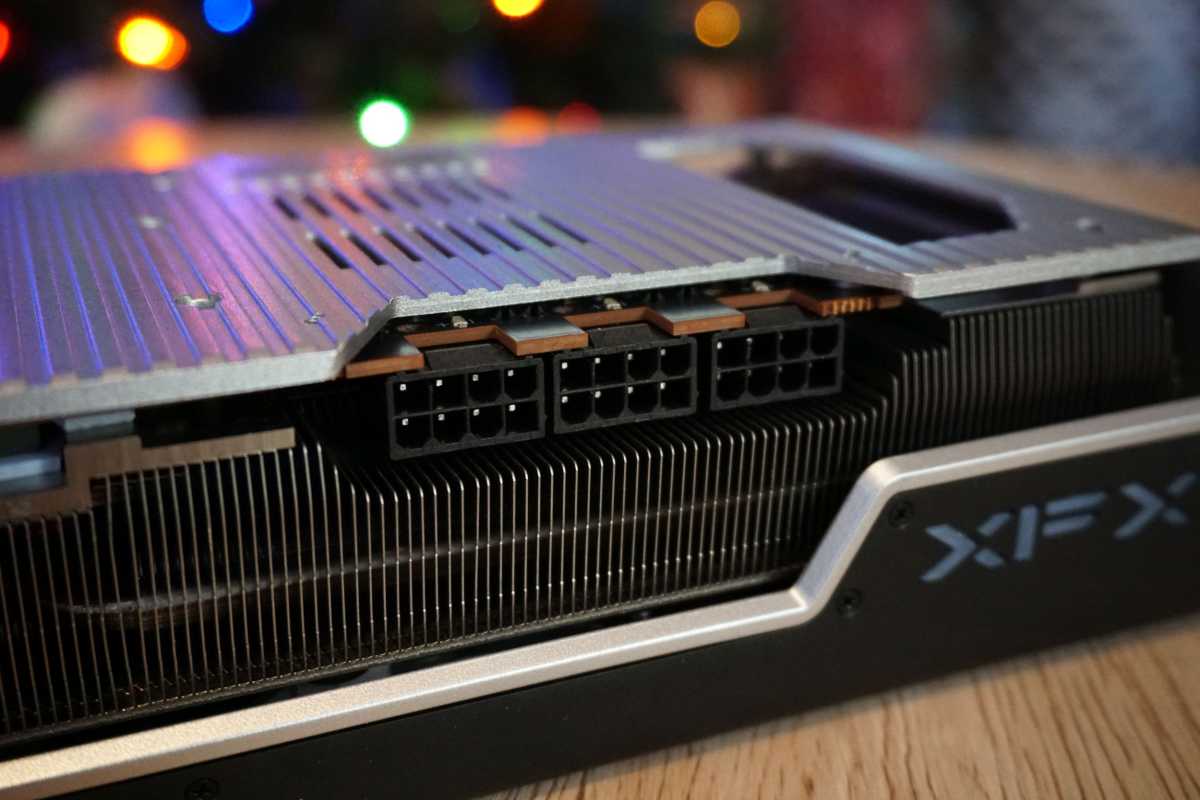
Brad Chacos/IDG
We don’t test overclocking prowess as part of our reviews, but we’re told the XFX card can be coaxed close to 3GHz if you manage to win the Silicon Lottery. The Merc 310 uses a full digital 15+2 phase design along with those three 8-pin power connectors to pump as much clean power as possible into the GPU, helping clock speeds soar.
We’ve been big fans of XFX’s Speedster design in recent generations and that holds true here. The Speedster Merc 310 7900 XTX is a big graphics card—measuring 3 slots thick and a loooooong 13.5 inches—but XFX loaded every inch with additional cooling prowess, which results in the card running dead silent and ultra-cool under load.

Brad Chacos/IDG

Brad Chacos/IDG
In addition to a massive full-length aluminum heatsink and three large fans with 13 blades apiece, XFX equipped the Merc 310 with a nickel-plated copper vapor chamber that cools both the GPU and the memory modules around it. XFX also took advantage of all the metal in the Merc, embedding no less than 20 different thermal pads throughout its interior to tame temperatures on the GPU, VRAM, power delivery system, and backside PCB components alike. The aluminum backplate offers 33 percent more surface area than XFX’s 6950 XT Merc, and several thermal pads connect it to the rear of the PCB to help keep temps down. Eight 6mm copper heat pipes snake throughout the heatsink’s fin stack to aid cooling endeavors even more. It’s frightfully effective, as you’ll see in our benchmarks section.
It’s also big and heavy with all that aluminum, nickel, and copper. Fortunately, XFX tosses a handy “Z support bar” into the box to combat against potential GPU sag concerns. It’s optional, but I’d use it in my own system. The Speedster Merc 310 7900 XTX is a beefy boi.
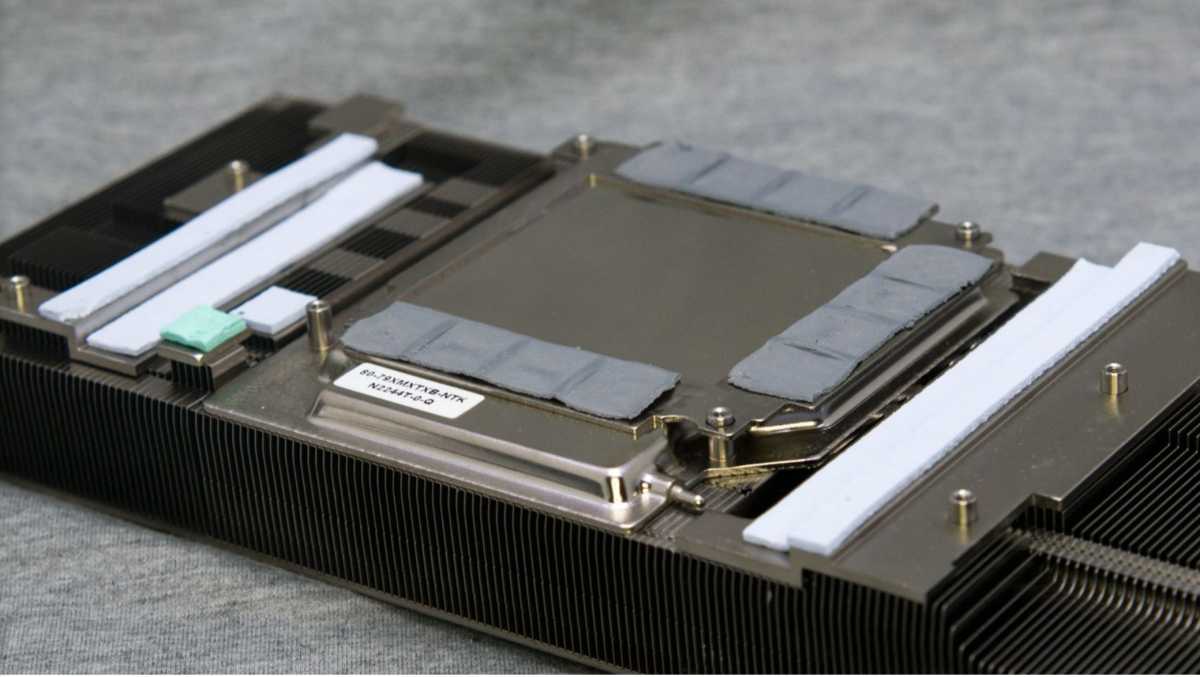
A look at vapor chamber inside the XFX Speedster Merc 7900 XTX.
XFX
I continue to love XFX’s modern aesthetics, which remind me of a muscle car and futuristic industrialist vibes smashed together. You won’t find RGB aboard this black-and-silver beauty, but the XFX logo glows a cool white when powered on. I like that XFX ditched the daring, but divisive “Merc” branding scrawled across the backplate in favor of a clean, unfettered look this time around. The Merc 310 also dumps the USB-C port found on AMD’s reference card in favor of a third DisplayPort 2.1 connection.
All in all, the XFX Speedster Merc 310 7900 XTX is huge, but effective and attractive. Yes please. Now let’s get to the benchmarks.
Our test system
We test graphics cards on an AMD Ryzen 5900X PC used exclusively for benchmarking GPUs. We now test with PCIe Resizable BAR (also known as Smart Access Memory on Ryzen systems) active, as most modern gaming PCs released in the last four years support the performance-boosting feature, either natively or via a motherboard firmware update. Nvidia also recommends turning on the optional “Hardware-accelerated GPU scheduling” option in Windows to let the RTX 40-series stretch its legs to the fullest, so we’ve made that tweak as well. Most of the hardware was provided by the manufacturers, but we purchased the storage ourselves.
We’re comparing XFX’s $1,099 Speedster Merc 310 7900 XTX against AMD’s own $999 7900 XTX and $899 7900 XT reference boards, of course, as well as Nvidia’s available RTX 40-series offerings. We’ve also included results from last generation’s most ferocious GPUs as well.
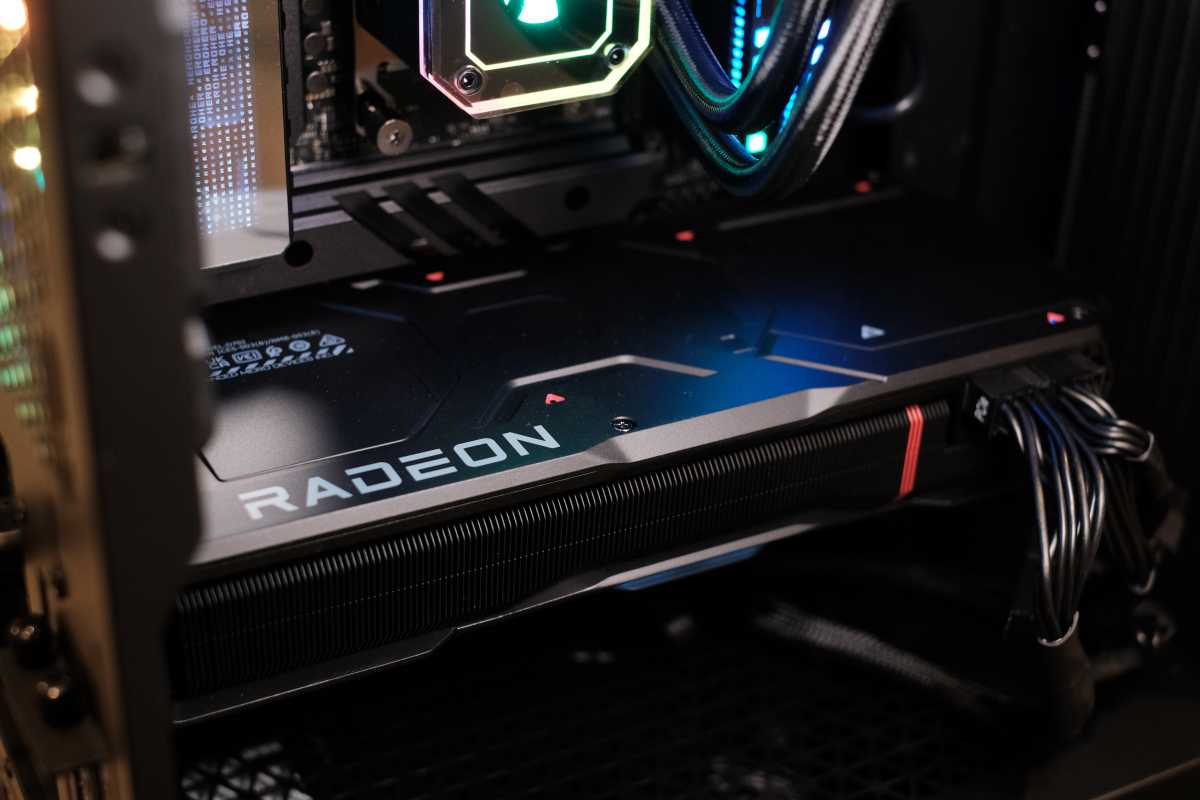
AMD’s reference RX 7900 XTX.
Adam Patrick Murray / IDG
We test a variety of games spanning various engines, genres, vendor sponsorships (Nvidia, AMD, and Intel), and graphics APIs (DirectX 9, 11, DX12, and Vulkan), to try to represent a full range of performance potential. Each game is tested using its in-game benchmark, sanity checked by Nvidia’s FrameView tool, at the highest possible graphics presets unless otherwise noted, with VSync, frame rate caps, real-time ray tracing or DLSS effects, and FreeSync/G-Sync disabled, along with any other vendor-specific technologies like FidelityFX tools or Nvidia Reflex. We’ve also enabled temporal anti-aliasing (TAA) to push these cards to their limits.
We run each benchmark at least three times and list the average result for each test. Outside of esports, we’ve limited our benchmarks to 4K and 1440p resolutions, as those are the natural fits for these juggernaut GPUs, most of which cost four figures or more at launch. The XFX’s factory overclock only provides a modest boost over the reference 7900 XT’s performance, so we’re going to preset these gaming benchmarks without commentary. For a deeper dive into gaming results, along with ray tracing and FSR/DLSS performance, check out our original Radeon RX 7900 XTX review.
XFX Speedster Merc 310 7900 XTX gaming performance benchmarks
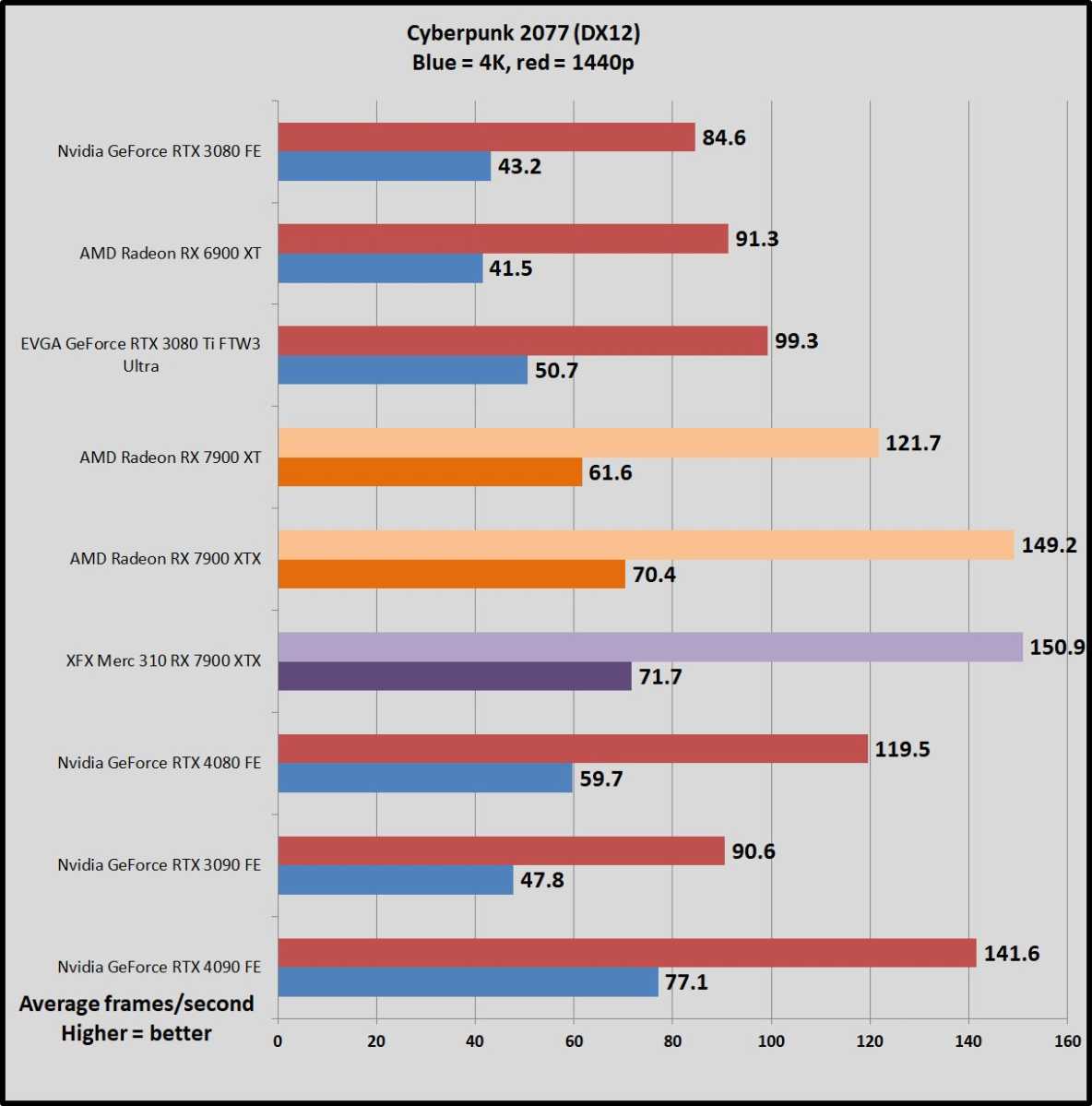
Brad Chacos/IDG

Brad Chacos/IDG
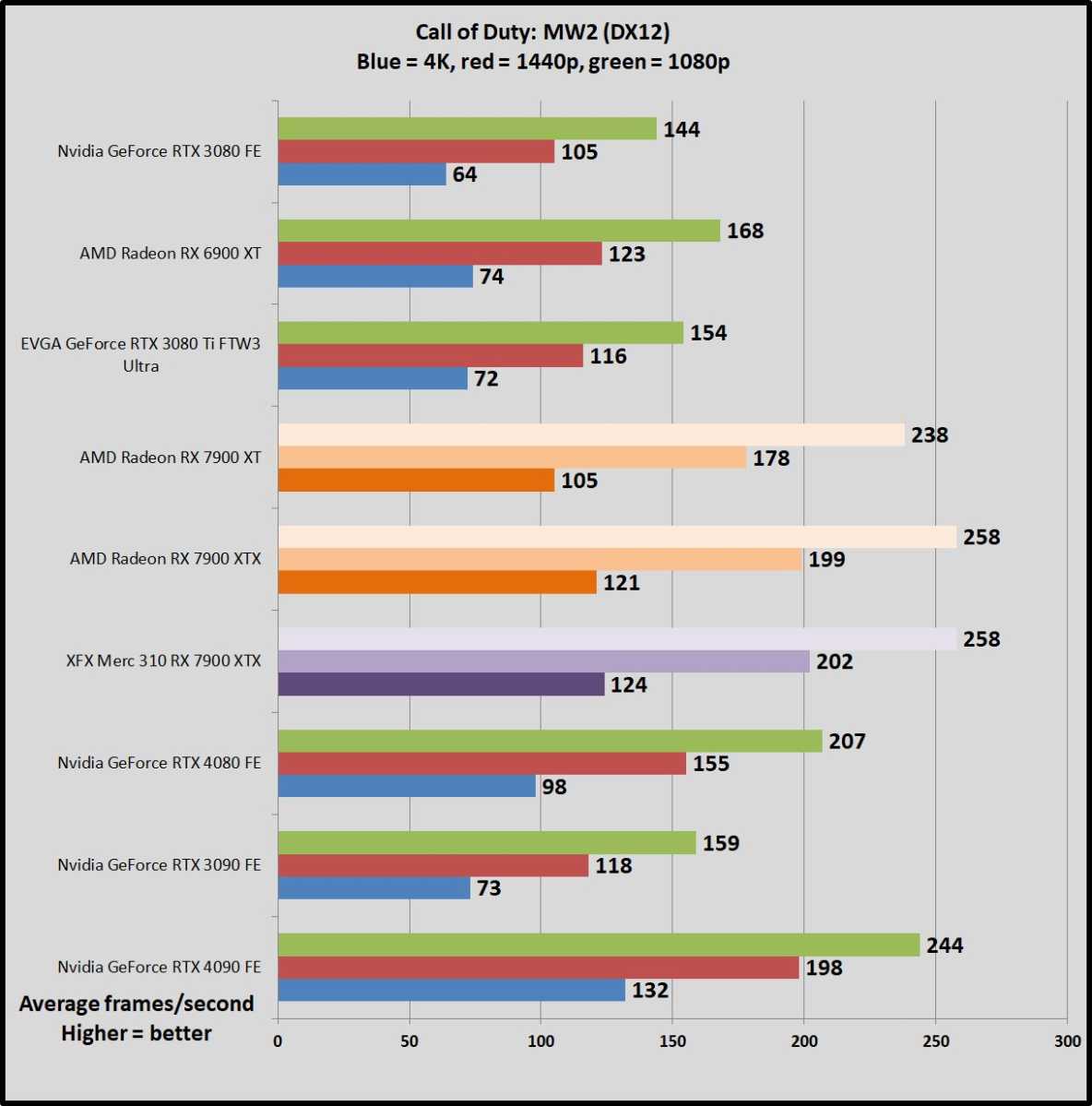
Brad Chacos/IDG

Brad Chacos/IDG
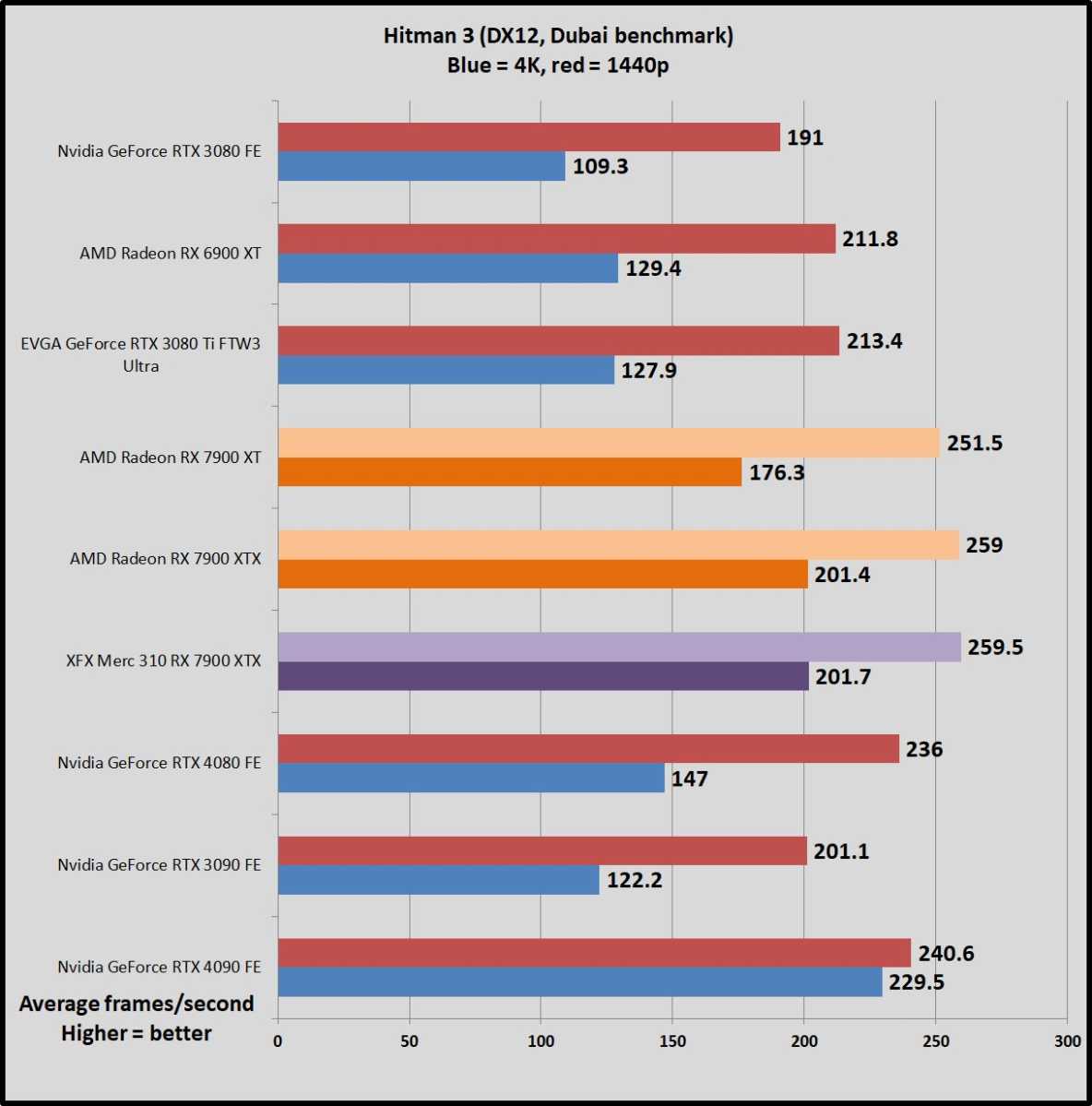
Brad Chacos/IDG
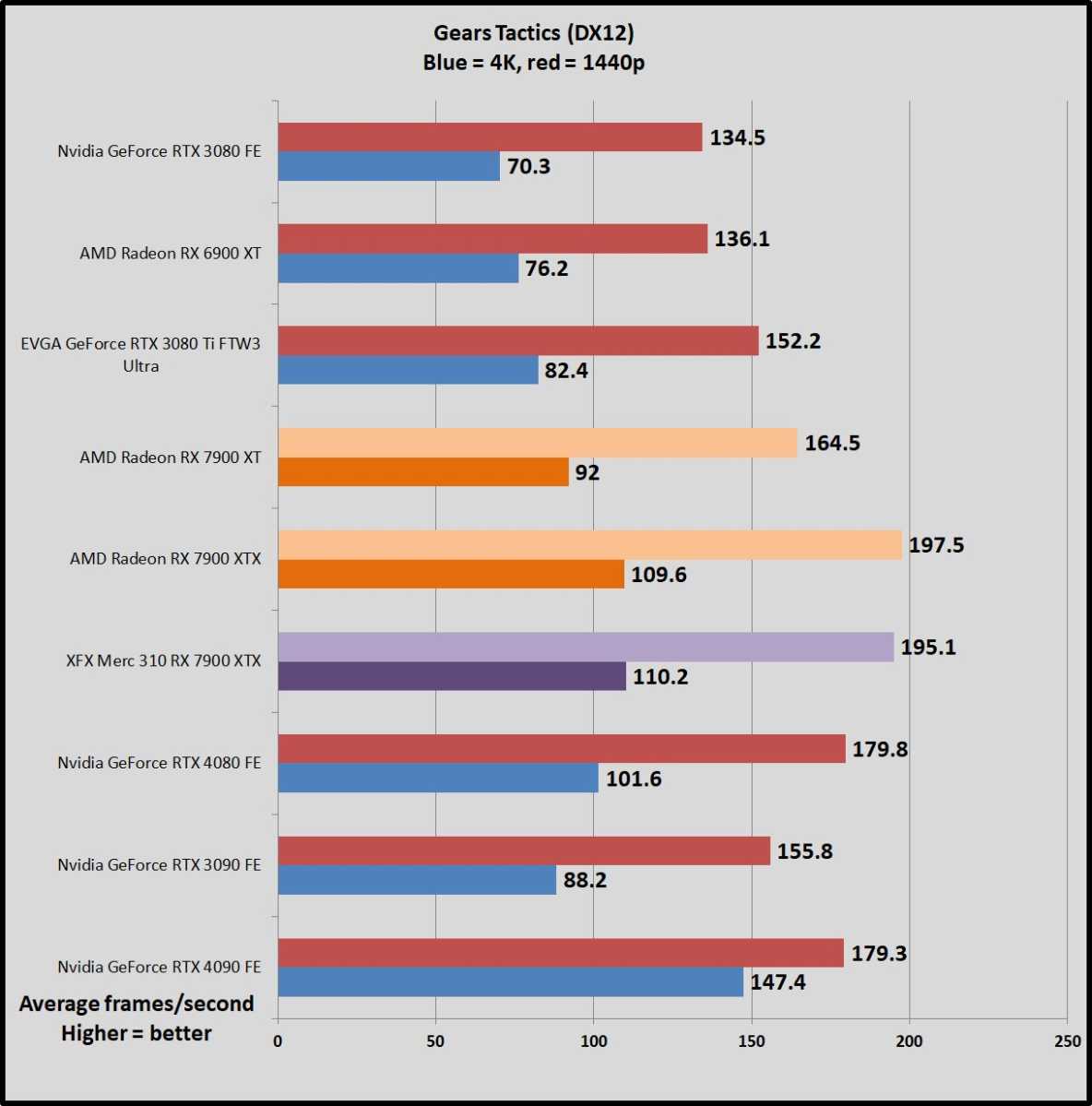
Brad Chacos/IDG
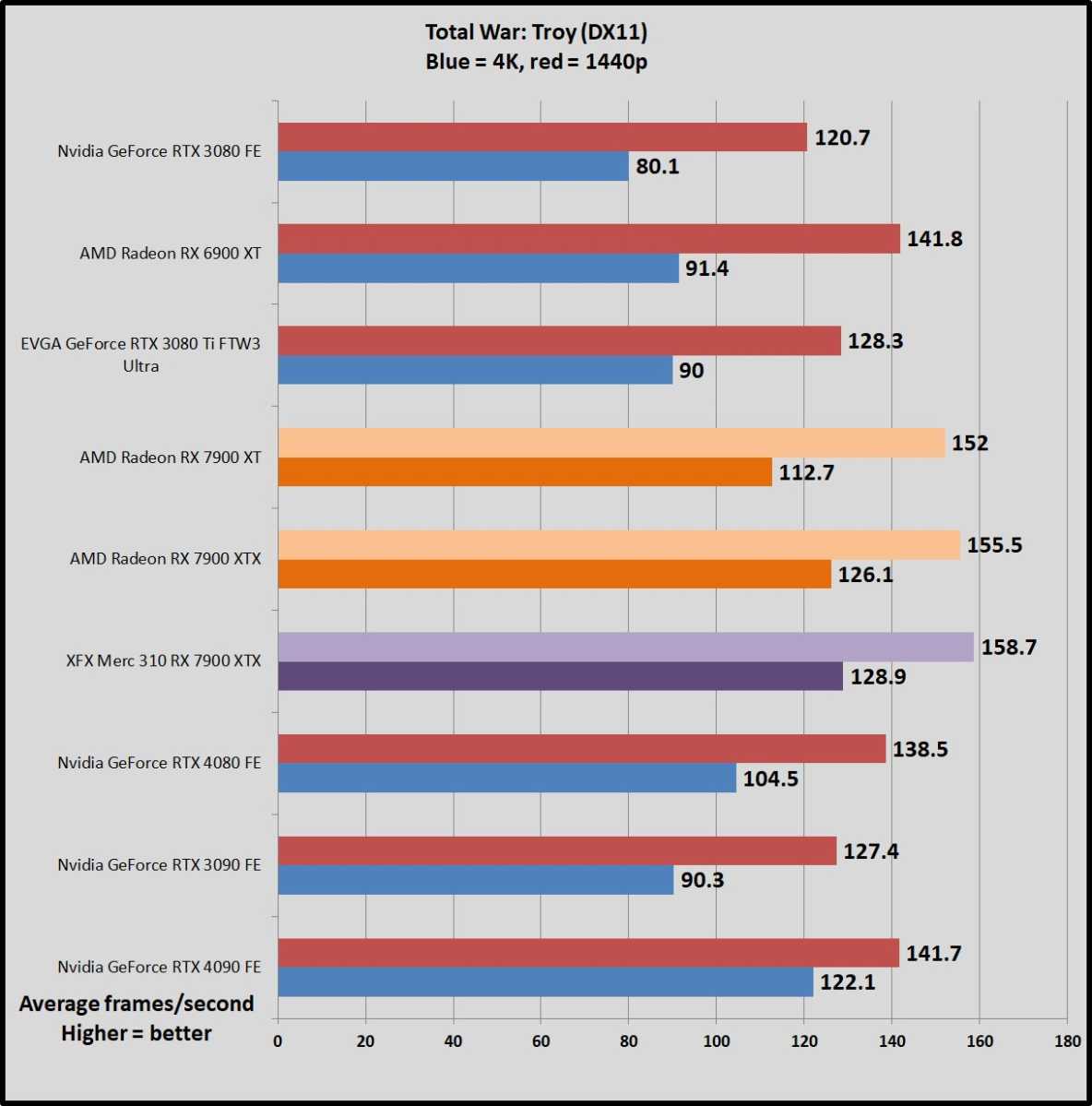
Brad Chacos/IDG
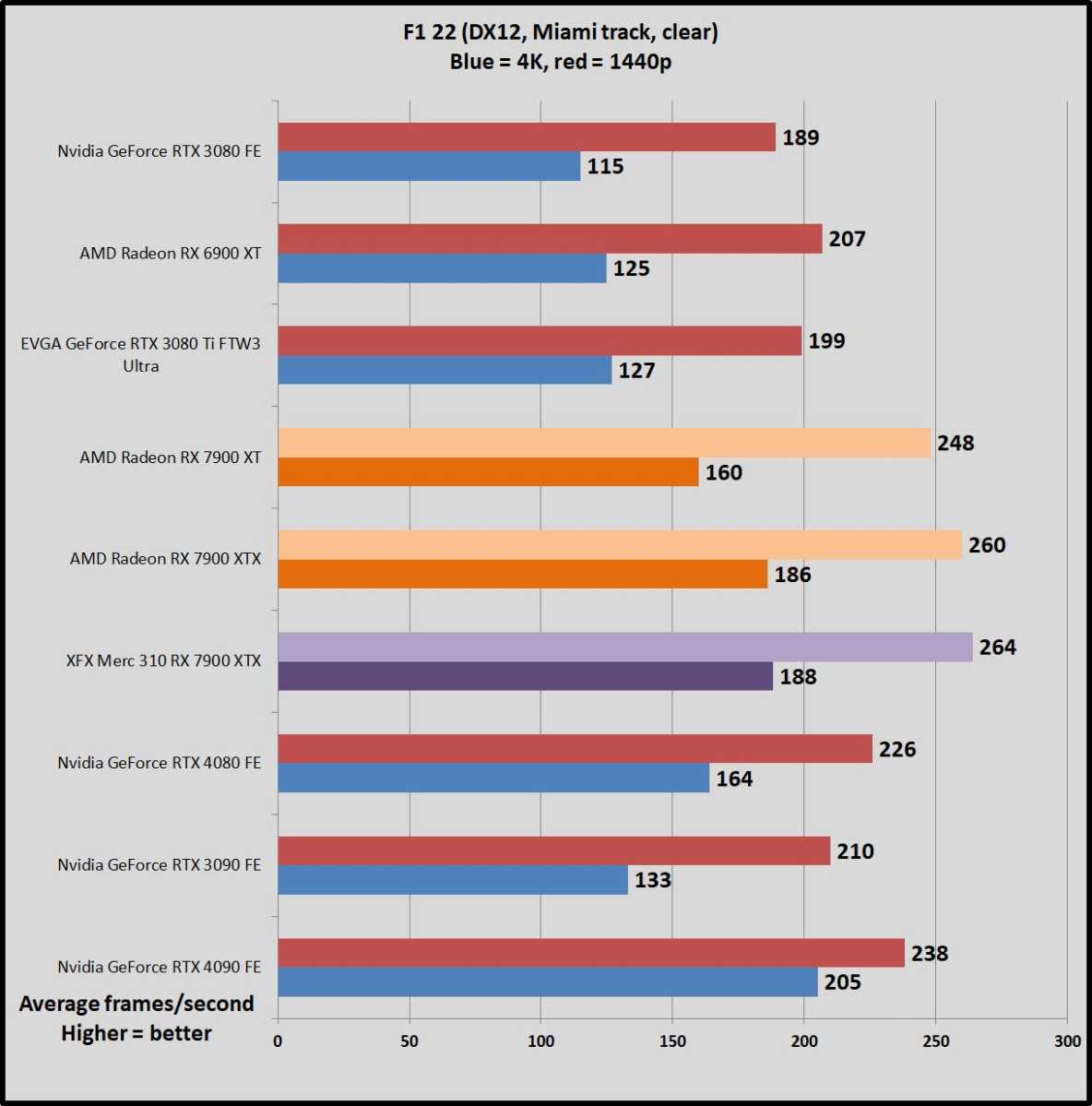
Brad Chacos/IDG
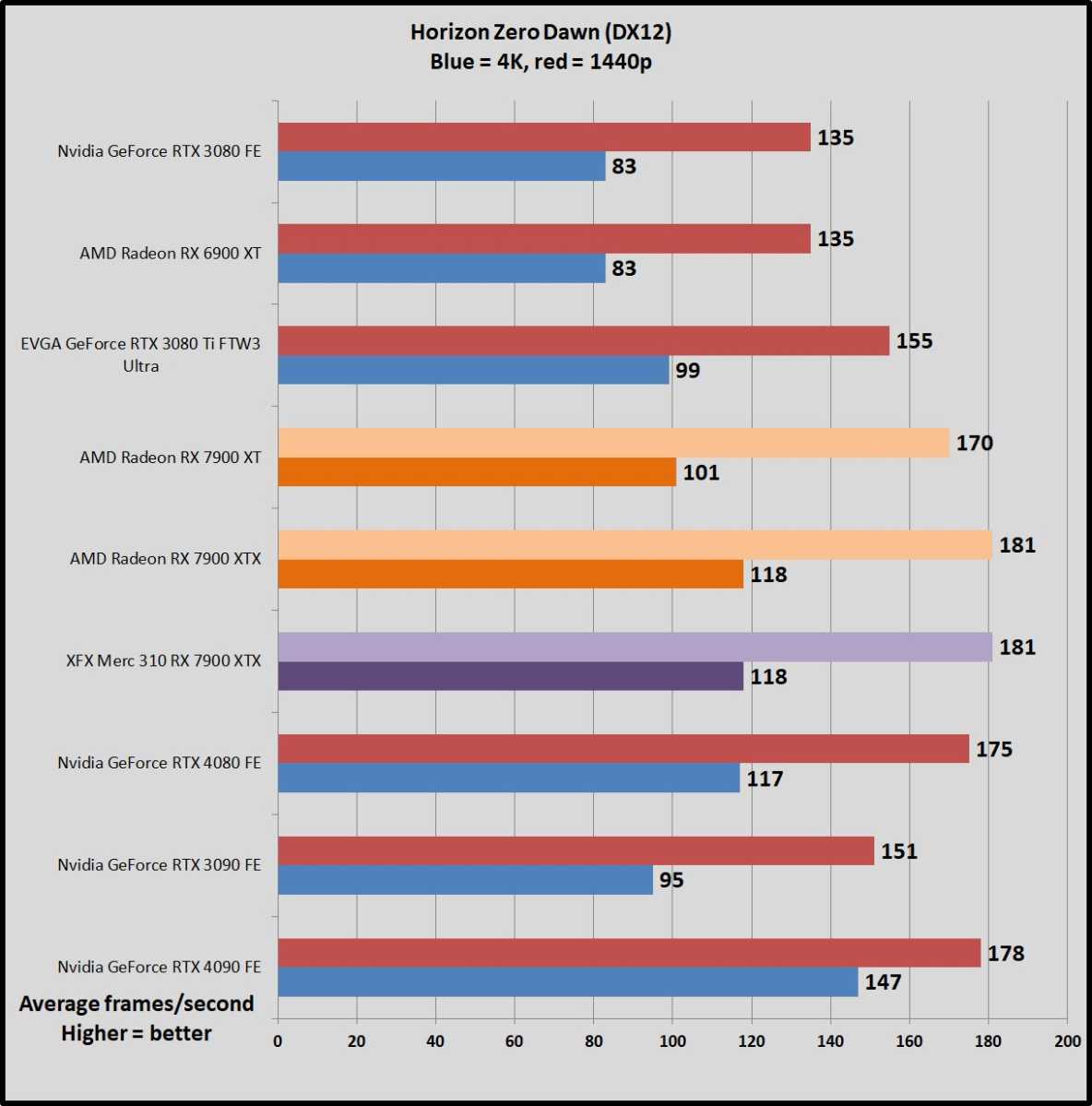
Brad Chacos/IDG
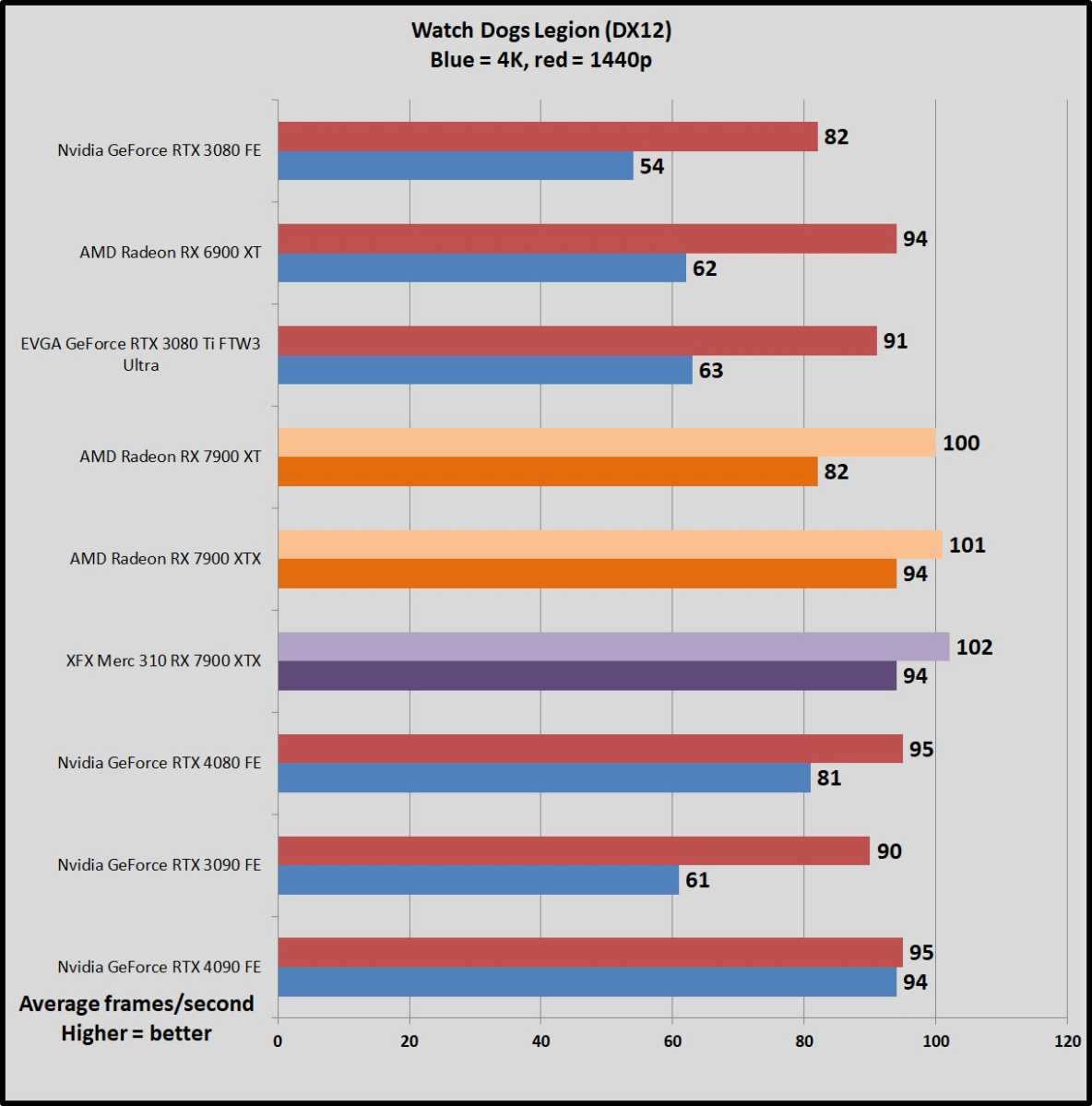
Brad Chacos/IDG
Power and thermals
We test power draw by looping the F1 22 benchmark at 4K for about 20 minutes after we’ve benchmarked everything else (to warm up the GPU) and noting the highest reading on our Watts Up Pro meter, which measures the power consumption of our entire test system. The initial part of the race, where all competing cars are onscreen simultaneously, tends to be the most demanding portion.
This isn’t a worst-case test; this is a GPU-bound game running at a GPU-bound resolution to gauge performance when the graphics card is sweating hard. If you’re playing a game that also hammers the CPU, you could see higher overall system power draws. Consider yourself warned.
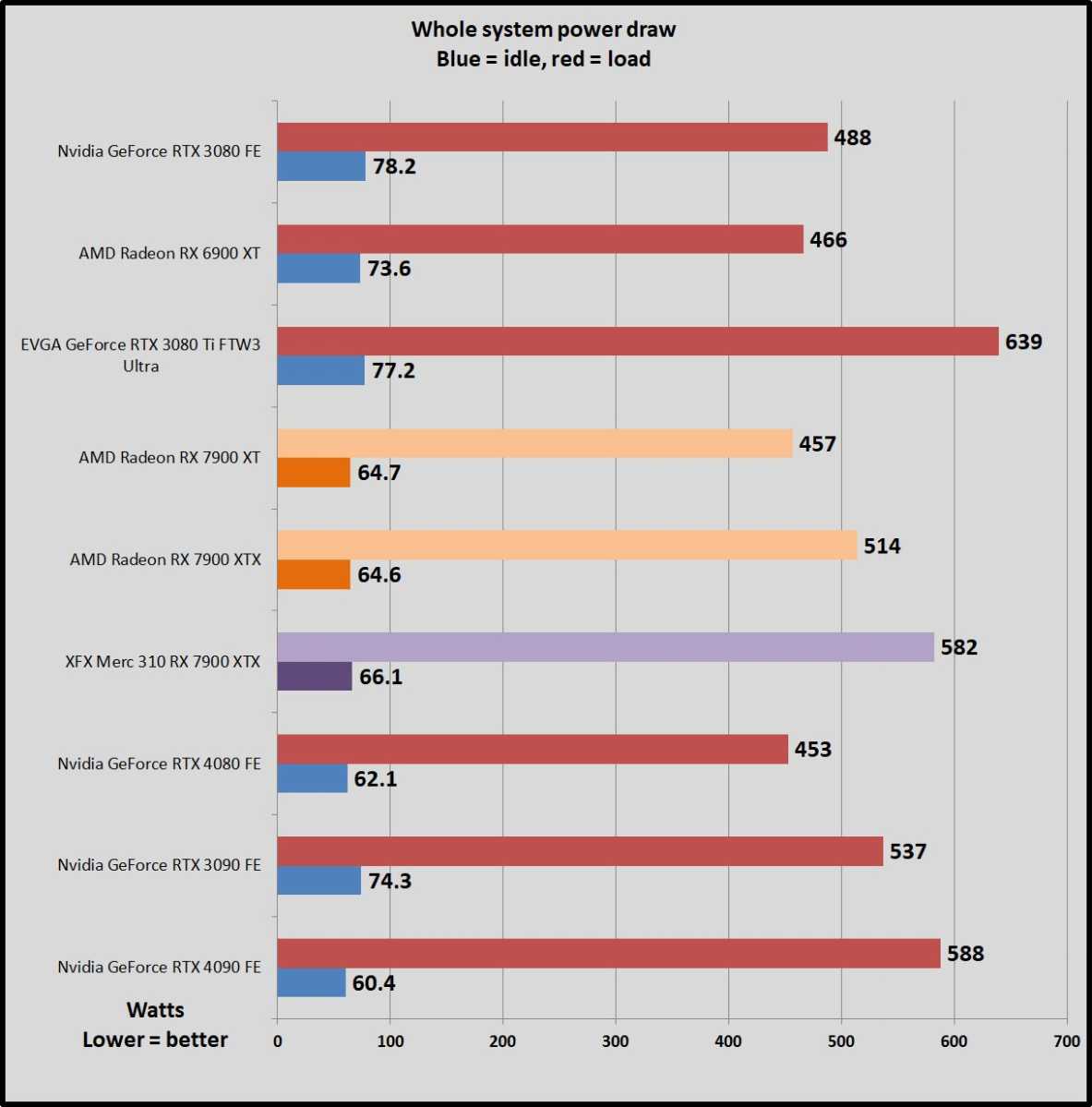
Brad Chacos/IDG
The Radeon RX 7900 XTX surprised us with its high power draw. Upping the wattage and cranking clock speeds makes the XFX Speedster Merc 310 suck down even more, putting it roughly on par with Nvidia’s RTX 4090. It’s still well behind the insane power draw of last generation’s custom RTX 3080 Ti GPUs, however.
We test thermals by leaving GPU-Z open during the F1 22 power draw test, noting the highest maximum temperature at the end.

Brad Chacos/IDG
Here is where the Speedster Merc 310 truly shines. XFX full-metal juggernaut manages to stay a full 13 degrees cooler than the AMD reference board, giving enthusiasts plenty of room to muck around with overclocking and other endeavors. Better yet, while our reference 7900 XTX model includes definitely audible (but not loud) fans and some surprisingly consistent coil whine, the XFX Merc 310 runs utterly silent. It’s a massive quality of life upgrade over the reference board.
Should you buy the XFX Speedster Merc 310 7900 XTX?
If you’re shopping for a roughly $1,000 to $1,200 new-gen graphics card, but don’t want to splurge $1,600 on the best-in-class GeForce RTX 4090, the AMD Radeon RX 7900 XTX delivers significantly more performance in many games than the $1,200 RTX 4080, while even going toe-to-toe with the 4090 at times. Ray tracing lags well behind the RTX 40-series, but you can still play ray traced games with similar levels of performance to the last-gen RTX 3090 flagship, so it’s certainly no slouch.
For deeper buying advice breakdowns, check out the conclusion of our original Radeon RX 7900 XTX review. In general, however, we consider the XTX to be a much better value than the RTX 4080 unless you place a heavy premium on ray tracing performance, DLSS 3 Frame Generation, and content creation workloads, which all favor Nvidia heavily. They’re secondary to just playing games, however, and the XTX shines on that front.
The real question is whether you should buy XFX’s custom board over AMD’s reference model.
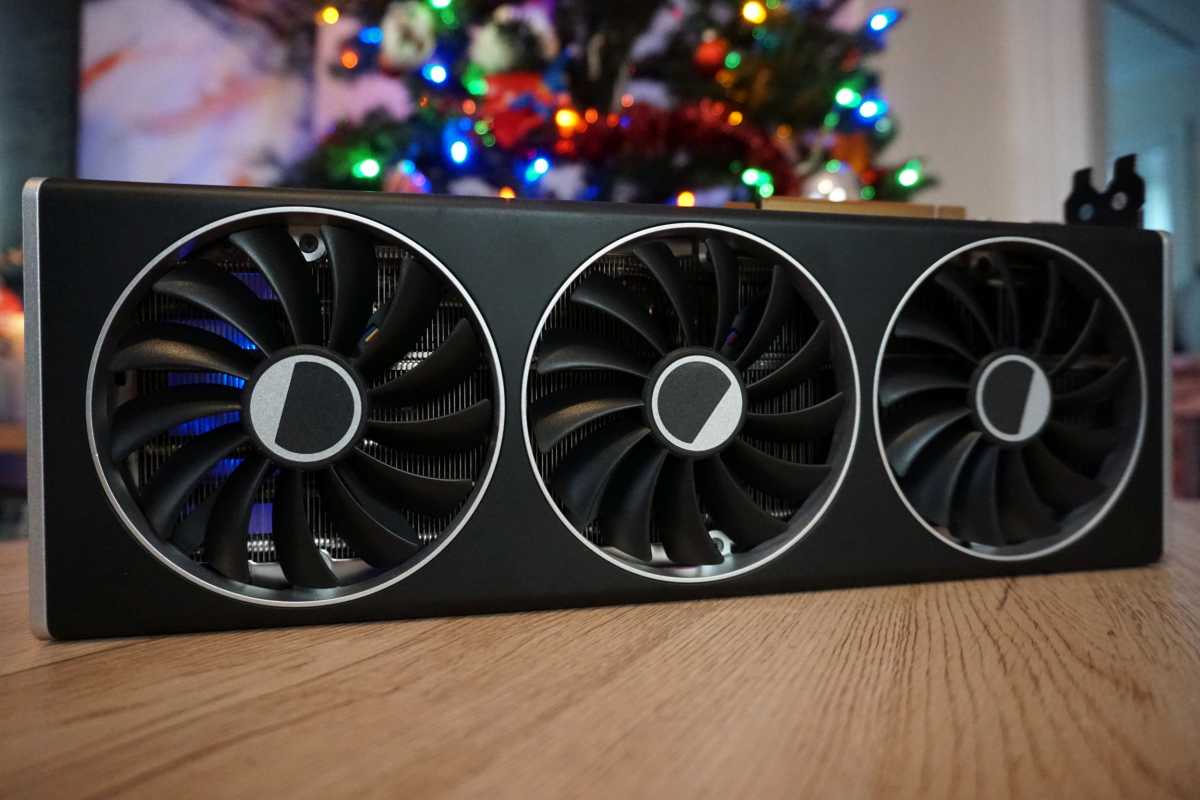
Brad Chacos/IDG
For most people, the answer is yes. If you need the reference 7900 XTX’s smaller size or USB-C port, it’s likely to be one of the few offerings to include that combination. The reference board is likely also one of the few offerings to stick to AMD’s $999 MSRP for the XTX if your budget is unyielding.
But if you can open your wallet further, XFX virtually perfects the 7900 XTX formula here. Spending an extra $100 gets you a graphics card that’s well faster than the RTX 4080 and can sometimes rival (or even beat) the vaunted 4090 during standard gameplay, in a package that’s attractive, ice cold, and utterly silent. XFX also threw in a max-power secondary BIOS and an extra power connector so overclocking enthusiasts have plenty of headroom to put all that cooling efficiency to work, though it lacks some specialized extra features (such as a fan control header and customizable RGB) you’ll no doubt find in rival custom cards.
And, most striking of all, the price you’re paying for this kick-ass custom XTX is still at least $100 less than the cheapest possible RTX 4080. That’s rad. The XFX Speedster Merc 310 7900 XTX is face-meltingly fast, impressively cool, dead silent, and a (relative) value option. Most people shouldn’t be shopping for four figure GPUs, but if you are, XFX’s custom card easily earns an Editors’ Choice Award and comes highly recommended.
For all the latest Technology News Click Here
For the latest news and updates, follow us on Google News.

